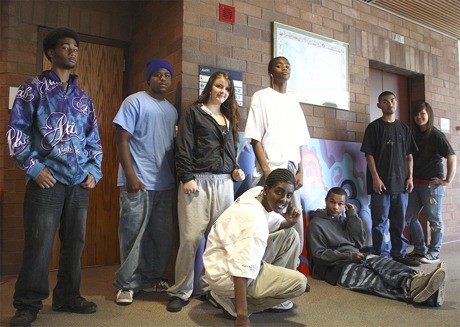A robbery charge landed Kentlake High School student James Curtis in the court system.
So when Seattle-based Artworks first offered him a summer job, he didn’t know where it would take him.
“My case manager offered me a job to keep out of trouble,” Curtis said. “He came to the house one day and told me there was going to be painting. I thought we were going to be painting houses or something at first.”
Instead of slapping paint on a house somewhere as part of a community service obligation, however, Curtis found himself with a part-time job. He and seven other youth – all labeled at-risk and in the court systems – painted murals at Auburn City Hall to hang on the construction fences at Les Gove Park.
Since 1995, Artworks, which started in the SODO District in Seattle, has sought to empower at-risk youth with professional opportunities in the arts.
The organization offers several programs, including the one ongoing in Auburn, which offers youth a part-time job, 20 hours a week, at minimum wage for several weeks during the summer.
“The intention is that they come here, and it’s a work program for them,” said Brendan Lattin, one of Artworks’ lead artists in the program. “They actually get paid. The idea is that by giving them something to do in the community and having a positive experience with better role models that may be available to them, it can help them make better decisions and give them alternative behaviors and lifestyles.”
Lattin, 30, said he has been with the company for about three years.
Although he already has a degree in sculpture, he is attending Seattle Central Community College in the graphic design program. During the summer he helps out with Artworks’ mural projects.
“I love it,” Lattin said. “It’s the best job I’ve ever had.”
In the past, Lattin said, he volunteered to teach art to homeless adults.
“With the adults, you didn’t really get the sense you were catching somebody in their developmental stage,” Lattin said. “I feel like modeling certain behaviors at this job. You can kind of intervene at certain stages in somebody’s life. You can’t change a person, but you can expose them to different ideas and show them different standards to live by, different expectations. A lot of the people I’ve met through this program actually have pretty low expectations because they live in impoverished circumstances.”
Like Lattin, Melissa Struyk is helping to mentor the youth in the program. She said she previously worked in the corporate world as an office manager. Her work with Artworks and the at-risk program for the past three years, however, has been a life changing event for her.
“It’s the kids that keep me real,” said Struyk, who is attending college to get her masters in education and teaching. “And they keep me honest. It takes a certain type to really want to work with teenagers and really understand them. It was through my work with Artworks that I decided to quit my job and go back to school.”
Taylor Hadden, 16, found her way to Artworks because of an altercation with another girl that escalated into physical violence. She said she jumped at the chance to go through the program because of her love for art and drawing.
“I had a choice and I choose to be here,” said the Kent-Meridian High School student.
For Hadden, like many of the other kids in the program, the job is a chance to reflect and learn.
“It’s given me a lot more patience than I had before,” Hadden said. “And this is my first job, so it’s taught me time management and how to work well with others. It’s a time to have a good time and not worry about the bad things in your life. It’s a time to think.”
In addition to giving the kids a chance to earn some money and learn real-world skills like promptness and accountability – things they can bring into the job market – the program also offers therapeutic benefits, according to Lattin.
“It’s a creative process and helps them come up with creative outcomes and solutions for problems,” he said. “Also, it’s just something that they have to focus on and be accountable.”
“I think these kids notice that it’s important to have a time to reflect,” Struyk added. “Things move so fast now, they watch TV, and there is a pop-up, and then there is news and it’s ‘what’s on next,’ then there is song and then they’re on the computer. This is a really good place for them to just have one focus and quiet their mind a little bit.”
Hadden agrees.
“It’s a great program, and I think a lot more people should do things like this,” she said. “It’s a good time to learn a little more about yourself.”
For the instructors, it’s also a chance to help instruct, empower and inspire.
“I just have a passion for working with kids that have been in troubled situations,” Struyk said. “It sounds really cheesy, but I feel like I’m a treasure hunter. They put up these really thick barriers. A lot of kids who have got in trouble before are labeled troublemakers. And when you recognize what they can bring to a positive space and you play that up, they speak to that and they flourish from that. If you expect a kid to act like a criminal, that’s what they’ll do. But if you expect them to do something with their life and really push them, they start thinking about what they really want to do.”
“It’s really helpful to empower them and tell them it’s possible to be a lawyer, it’s possible to be this,” Lattin added. “And tell them they can expect more out of life.”



